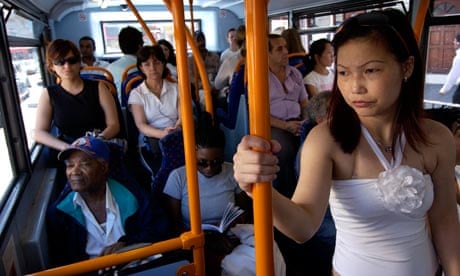Local bus journeys in London have fallen by 0.6% this year. But the bigger 2.5% drop for the rest of England means that bus journeys in London now make up the majority of bus travel in the country.
The latest figures from the Department for Transport showed that 4.6bn local bus journeys were made in England during 2012/13 with 2.4bn of those taking place within London's borders.
Bus travel in England has declined 6.2% from 2008/9, the year that free concessionary travel was introduced. The joint-report by the Office for National Statistics and the DfT also points out that this was the year the economic downturn began.
Relatively speaking though, bus travel in London has flourished. It has grown by 3.9% since 2008/9 and by 28.4% since 2004/5 when 1.8bn journeys were made in the capital.
Public funding for buses in London was upped considerably in the mid '90s, which started a growth trend that wasn't consistent with the rest of the country.
Local travellers shun buses
While in London there are 279 local bus journeys for every resident, the rest of England has an average of just 51. So it seems bus travel is just not the ticket for residents in many local authorities.
The area with the least bus journeys per head was the tiny county of Rutland, which had just 2.7 journeys for every resident (1/100th of London's rate) although the small population may distort the figures there. The other places with lower proportions of bus travel tended to be rural areas such as Windsor and Maidenhead.
Outside London, Nottingham and Brighton had the highest number of journeys per resident with both coming in around 160 - over three times the average for all authorities outside London.
The low car ownership in both those places and the tendency for bus travel to be lower in rural areas adds weight to the report's argument that there is a noticeable correlation between increased bus travel and lower car ownership.
What's stopping us using buses?
As noted before the report points out that there was a rise in bus transport in 2008/9 following the introduction of free concessionary travel. Also, 2008/9 was the year when the financial crisis really began to take hold.
As it stands, about a third of bus journeys in England are taken by concessionary travelers. However, those that have to pay have been continually hit by fare rises above inflation. That trend continued in 2012/13 with an an average fare rise of 4.7% for Englanders both outside and inside the capital.
Do increased fares mean better service? 82.8% of buses are judged to have been "on time" in regions outside London, which means they arrived between one minute early and 5.59 minutes late. This was a 0.1 percentage point drop drop on last year but a a 3.4 point increase on 2009/10.
Passengers in Darlington faced the most waits for their buses in 2012/13. Over a third of buses in the North East town were judged to have been late.
Bus providers and accessibility
Bus journeys are the only option for some passengers in major cities due to the lack of disabled access on other modes of transport such as the underground.
In London, 97% of buses have been given accessibility certificates, which confirm the bus conforms with anti-discrimination regulations. In the rest of England, only 71% of the bus fleet have got the same certification.
However, the situation is much improved on 2004 when just one in five buses outside of London had accessibility certification.
It is also worth noting that when un-certificated buses with low-floor-access for wheelchairs are added to the total then 91% of buses across England could be deemed wheelchair accessible.

Comments (…)
Sign in or create your Guardian account to join the discussion